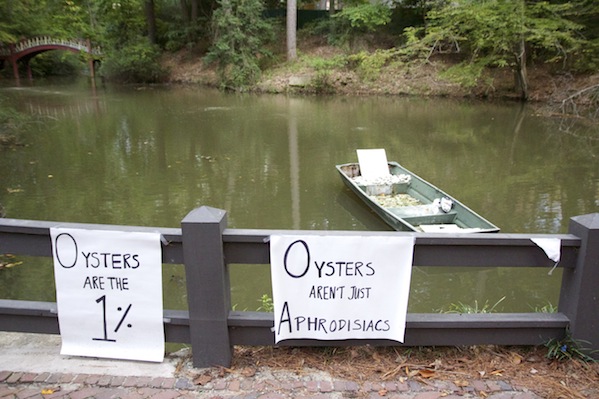There are plenty of opportunities to see art at the College of William and Mary, whether it is in an art history class, the Muscarelle Museum of Art or a friend’s art project. For the past few weeks students have had an opportunity to see art in a more unexpected location: as they walk by the Crim Dell.
Rachel Merriman-Goldring’s ’17 art installation has been set up on the Crim Dell to demonstrate the declining oyster population in the Chesapeake Bay.
“I’ve been interested in the Chesapeake Bay for a really long time,” Merriman-Goldring said. “I’m particularly interested in looking at local environment[al] issues because I think they’re easiest for people to connect to.”
Merriman-Goldring originally proposed the art installation as part of a final project for a class.
“My installation illustrates the historic decline in oyster populations … the fact that recent oyster populations lows have been less than one percent of historical highs,” Merriman-Goldring said.
Merriman-Goldring said that various groups and individuals helped her acquire the boat. Biology Professor Randolph Chambers assisted her throughout the project.
“One of the greatest parts of this project — it’s sort of inherently interdisciplinary,” Merriman-Goldring said. “I’ve been able to have the help of so many people at the College but also outside of the College.”
The old-fashioned fishing boat is one of her favorite aspects of her project, Merriman-Goldring said.
“I like the aesthetic sort of contrast because I’m using this very old, very stereotypical fishing boat as a way to illustrate historic highs and then, I’m using this very modern plastic toy boat as a way to illustrate modern lows,” she said.
Students commented on the visual appeal of the old-fishing boat set against the background of the Crim Dell.

The location of the installation on the Crim Dell in the center of campus has caught some students’ eyes.
“I really like the concept,” Veronica Gray ’14, a visiting alumna, said. “It looks really deserted.”
Chambers agreed that the installation’s location contributes to its impact.
“The location of the project and the presence of a boatload of oysters in Crim Dell invites people to stop and figure out the message that Rachel is trying to convey,” Chambers said in an email. “To date, I think it has been pretty effective.”
The installation has generated conversation on campus. An imitation of the project was even set up outside of Earl Gregg Swem Library. An anonymous student set up a shoe-box in front of a tree with a sign saying “Trees are the 1 percent,” a direct reference to one of Merriman-Goldring’s poster boards in front of the boat.
“I was sort of torn about how I felt about it,” Merriman-Goldring said about the imitation. “At first I really liked it. People say that mimicry is the most sincere form of flattery. I’m not sure that’s true. But it meant that people were engaging, which is awesome.”
Merriman-Goldring said her main goal with the project was to educate viewers and make them think. She said she is comfortable with any criticism.
Merriman-Goldring also stood by the Crim Dell on the first day was the project was installed, listening to students’ conversations to see what they thought of the initiative.
Some students admitted to being originally confused by the project.
“I think it’s nice against the bridge, but I guess I didn’t understand the significance,” Amanda Tosi ’18 said.
Merriman-Goldring plans to keep the project up until mid-November, when the Model UN conference comes to campus, to spread awareness about oysters to a wider audience. She said she hopes that the installation will get as many people concerned about the oyster decline as possible.
“I think helping people visualize statistics and helping people make a sort of more personal connection to the information that they’re learning empowers them and makes them more engaged citizens,” Merriman-Goldring said.


[…] Link to article – Oyster campus art raises awareness of declining oyster populations […]